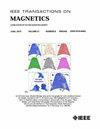线性管状电磁源涡流阻尼器的电磁机理及缓冲性能分析
IF 1.9
3区 工程技术
Q3 ENGINEERING, ELECTRICAL & ELECTRONIC
引用次数: 0
摘要
基于麦克斯韦方程组的磁矢量势形式和层理论,推导了电磁力源涡流阻尼器阻尼力的理论计算公式。通过有限元建模和静磁场试验验证了公式的准确性,阻尼力-速度曲线的最大误差小于3%。通过与永磁源涡流阻尼器(PS-ECD)的对比,揭示了ES-ECD阻尼力-速度关系的电磁演化机制。结果表明,ES-ECD的临界速度较低,超过临界点后阻尼力的非线性增强,这是由于时变场中产生的反向磁场增强所致。轴极-螺距比$\alpha $显著影响ES-ECD的非线性特性,单位安培匝阻尼力在$\alpha =0.65$时达到最大值。ES-ECD的非线性特性使得阻尼系数对导体厚度和气隙的变化更为敏感。在低速时,较高的非线性阻尼系数拓宽了传统涡流阻尼器(ECDs)的最佳参数范围,增强了通用性。通过对跌落块体冲击缓冲系统动态响应特性的数值模拟,验证了ES-ECD比PS-ECD缓冲性能提高20.6%,有效吸收了系统的冲击能量,实现了快速的减振。本文章由计算机程序翻译,如有差异,请以英文原文为准。
Electromagnetic Mechanism and Buffering Performance Analysis of Linear Tubular Electromagnetic Source Eddy Current Dampers
This study derives a theoretical formula for calculating the damping force of the electromagnetic source eddy current damper (ES-ECD) based on the magnetic vector potential form of Maxwell’s equations and layer theory. The accuracy of the formula is validated through finite element modeling (FEM) and a static magnetic field test, with a maximum error of less than 3% in the damping force–velocity curve. A comparison with the permanent-magnet source eddy current damper (PS-ECD) reveals the electromagnetic evolution mechanism underlying the damping force–velocity relationship of the ES-ECD. The results indicate that the ES-ECD exhibits a lower critical velocity and enhanced nonlinearity in the damping force beyond the critical point, attributed to the intensified opposing magnetic field generated in the time-varying field. The axial pole-pitch ratio, $\alpha $ , significantly influences the nonlinear characteristics of the ES-ECD, with the damping force per unit ampere-turn reaching its maximum at $\alpha =0.65$ . The nonlinear characteristics of the ES-ECD make the damping coefficient more sensitive to variations in conductor thickness and air gap. At low velocities, the higher nonlinear damping coefficient broadens the optimal parameter range of traditional eddy current dampers (ECDs), offering enhanced versatility. Through numerical simulation of the dynamic response characteristics of the impact buffering system for the falling mass block, it has been verified that the ES-ECD can achieve up to a 20.6% improvement in buffering performance compared to the PS-ECD, effectively absorbing the system’s impact energy and achieving swift vibration attenuation.
求助全文
通过发布文献求助,成功后即可免费获取论文全文。
去求助
来源期刊

IEEE Transactions on Magnetics
工程技术-工程:电子与电气
CiteScore
4.00
自引率
14.30%
发文量
565
审稿时长
4.1 months
期刊介绍:
Science and technology related to the basic physics and engineering of magnetism, magnetic materials, applied magnetics, magnetic devices, and magnetic data storage. The IEEE Transactions on Magnetics publishes scholarly articles of archival value as well as tutorial expositions and critical reviews of classical subjects and topics of current interest.
 求助内容:
求助内容: 应助结果提醒方式:
应助结果提醒方式:


